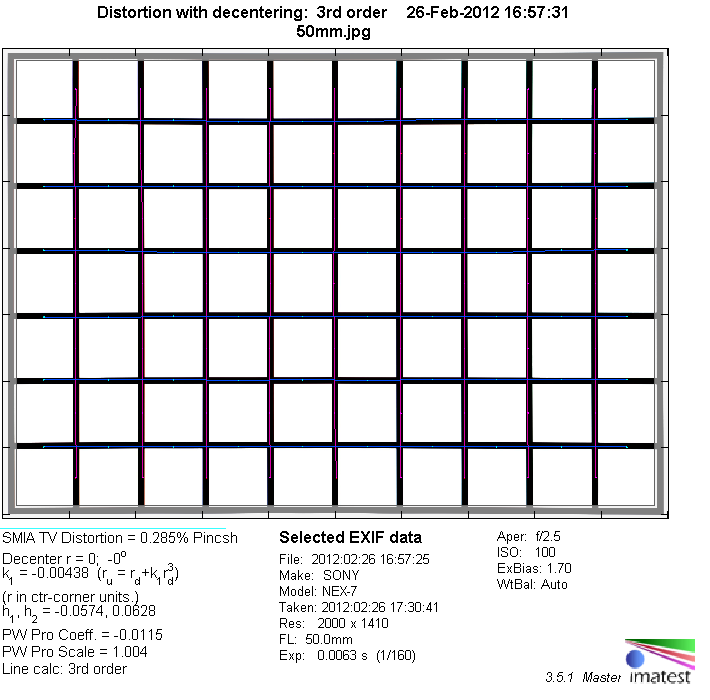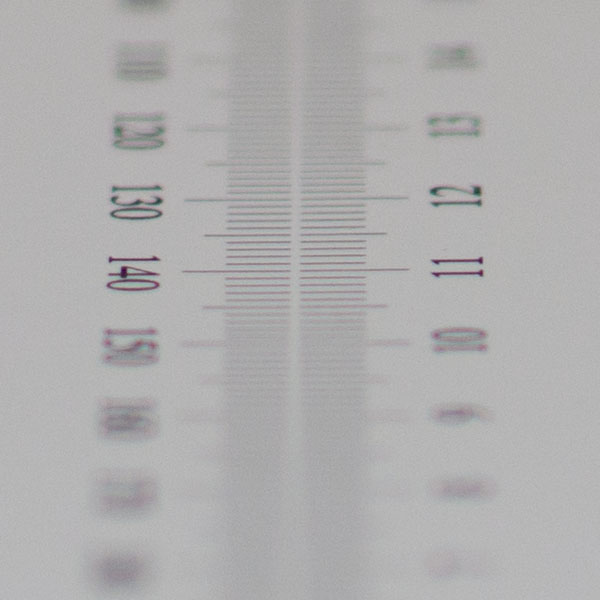|
Sony E 50mm f/1.8 OSS (SEL-50F18) - Review / Lens Test - Analysis |
|
Lens Reviews -
Sony NEX
|
|
Page 2 of 3

Distortion
The Sony lens produces a marginal amount of pincushion distortion (~0.3%) which is not objectionable in field conditions.

Vignetting
The light fall-off is quite heavy at f/1.8 (~1.6 f-stops) - this will be noticeable in most field images. Stopping down to f/2.8 eases the issue a little bit but it takes f/4 to reduce it to a negligible degree.

MTF (resolution)
The camera sensor of the Sony NEX 7 has a rather difficult resolution characteristic for lenses specifically at large aperture settings - the corner quality is substantially dampened based on what we've seen so far. However, we still feel that it is appropriate to restart our Sony E tests based on this camera. After all this is Sony's flagship model (as of 2012).
The Sony lens is capable of delivering a very sharp center performance straight from f/1.8. This is the good news. The border and corner quality is rather soft here although the NEX 7 sensor has surely is share of responsibility for this. Stopping to f/2.2 lifts the border quality to good levels whereas the corners remain weak. There's a substantial increase in quality at f/2.8 with an excellent center, very good borders and good (just) corners. The peak performance is reached between f/4 and f/8 with a very good image quality across the image frame. Diffraction has an higher impact from f/11 onward.
The centering quality of the tested sample was acceptable but not superb. This is, unfortunately, something we got used to with Sony E lenses.
Please note that the MTF results are not directly comparable across the different systems!
Below is a simplified summary of the formal findings. The chart shows line widths per picture height (LW/PH) which can be taken as a measure for sharpness.
If you want to know more about the MTF50 figures you may check out the corresponding Imatest Explanations
Chromatic Aberrations (CAs)
The Sony lens produces an average CA (color shadows at harsh contrast transitions) pixel width of around ~1.3px at the image borders. This is decent considering the extremely high pixel density of the 24 megapixel sensor.

Bokeh
It is nice to have a sharp ultra-large aperture lens but it is also important to have a very smooth bokeh (quality of the out-of-focus blur) which is simply part of the character of such a lens. The Sony E 50mm f/1.8 OSS delivers superb results here - which is really a rare quality at this focal length!
Out-of-focus highlights are rendered smoothly at max. aperture as well as stopped down. The circular highlight shape remains intact till about f/2.8. At max. aperture you can observe some shape deterioration towards the corners but this is quite normal.
 The out-of-focus blur is buttery both in the image back- and foreground. It is seldom to have both areas rendered that good!
The out-of-focus blur is buttery both in the image back- and foreground. It is seldom to have both areas rendered that good!

Bokeh Fringing / Longitudinal Chromatic Aberrations (LoCA)
Bokeh fringing is a common issue with relatively fast glass. It's visible as halos of different colors in out-of-focus areas - magenta (red + blue) in front of the focus point and green beyond.
Typical for most fast primes, the 50mm f/1.8 OSS shows noticeable bokeh fringing at large aperture settings, which can of be reduced by stopping down. However, the effect remains slightly visible even at f/4.
|
Move the mouse cursor over the f-stop marks below to observe the respective LoCAs
|
| f/1.8 |
f/2.2 |
f/2.8 |
f/4 |
|

|
|